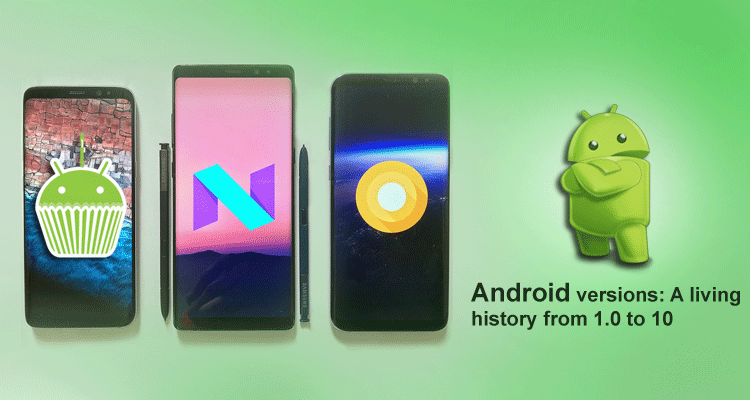Android Versions: A living history from 1.0 to 10

Versions 1.0 -1.1
The first version of Android released on the HTC G1. It included all the basic Google programs along with synchronization. In February 2009, Version 1.1 added the capability of saving attachments in messages.
Version 1.5: Cupcake
Cupcake introduced the first on-screen keyboard to android revolution.
Version 1.6: Donut
Donut introduced the facility for the OS to operate on a variety of different screen sizes and resolutions.
Versions 2.0 – 2.1: Eclair
Support for Bluetooth hands-free, push notifications, Wi-Fi hotspot functionality, and greater screen resolution. Search expanded to include SMS and MMS messages, and HTML5 support in the browser. More camera features, including flash, zoom and white balance.
Version 2.2: Froyo
On May 20, 2010, the SDK for Android 2.2 was released, based on Linux kernel 2.6.32. Froyo introduced some important front-facing features, including the addition of the now-standard dock at the bottom of the home screen.
Version 2.3: Gingerbread
Introduced on the Samsung Galaxy Nexus S, support was added for VoIP, enhanced copy/paste, front-facing camera, AAC audio and near field communication (NFC). Gingerbread allowed for screens with WXGA and higher resolution.
Version 3.0 – 3.2: Honeycomb
Touted as “3D Holographic,” it added toolbars at top and bottom and incorporated tabbed browsing and other desktop features.
Version 4.0: Ice Cream Sandwich
ICS added a raft of new features, including facial recognition unlocking, resizable Widgets, Wi-Fi Direct and touchscreen keys in lieu of hardware Home, Menu and Back buttons.
Versions 4.1 – 4.3: Jelly Bean
Multiuser support also came into play, albeit on tablets only at this point, and an early version of Android’s Quick Settings panel made its first appearance.
Version 4.4: KitKat
KitKat was optimized to run on a greater range of devices than earlier Android versions, having 512MB of RAM as a recommended minimum; those improvements were known as “Project Svelte” internally at Google.
Versions 5.0 and 5.1: Lollipop
The card-based concept that had been scattered throughout Android became a core UI pattern — one that would guide the appearance of everything from notifications, which now showed up on the lock screen for at-a-glance access, to the Recent Apps list, which took on an unabashedly card-based appearance.
Version 6.0: Marshmallow
Major features were Android Pay mobile payment system and standardized fingerprint support, automatic data backup to the Google cloud, more context awareness of the user in Google Now and integration of the SD card into internal storage.
Versions 7.0 and 7.1: Nougat
If the app is compliant, it could be resized and moved around on the screen as with a desktop computer. The Settings menu showed more information without going to a second level, a slider changed the display resolution and emergency info could be displayed on the lock screen.
Version 8.0 and 8.1: Oreo
Android Oreo added a variety of niceties to the platform, including a native picture-in-picture mode, a notification snoozing option, and notification channels that offer fine control over how apps can alert you.
Version 9: Pie
Version 9 provides numerous enhancements. Multiple and external cameras are supported, and apps for work can be visually separated. Up to five Bluetooth devices can be connected, and incoming calls can be sent to all of them with different volume levels.
Android Version 10
The stable version of Android 10 was released on September 3, 2019. Features are Access system settings directly from apps using floating panel, Foldable phones support, Dark theme, Gesture navigation

